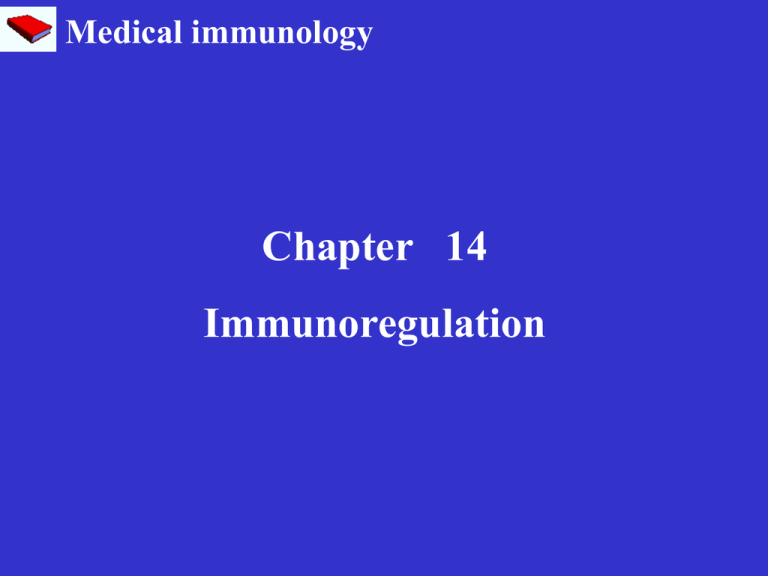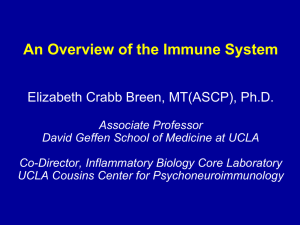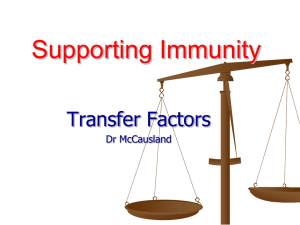
Medical immunology
Chapter 14
Immunoregulation
教学大纲
• 熟悉T细胞亚群及其相互调节机制、独特
性网络和抗原内影象概念
• 了解抗原、抗体、抗原抗体复合物、补
体以及ITAM/ITIM对免疫应答的调节作
用
• 了解免疫应答的基因调控、凋亡机制对
免疫应答的调节以及整体和群体水平的
免疫调节
免疫调节(immunoregulation):
the body control persistent and
intensity of immune response by positive or
negative regulators in order to maintain the
balance of the whole body.
functions:
1. enhance immunity ,eliminate
foreign antigens ;
2. diminish harm to self tissues。
Section 1
Discription
I . Sensing of immune system
precondition of immunoregulation
II . Sensing signals by immune system
& Quantitative change and qualitative
alteration of immune molecule
*Antigen doses
*Antibody concentration
*Proporation between Ag and Ab
& Quantitative change of Immune cells
clone
& Affinity between ligand and receptor
III . Mechanism of negative regulation play
a major role
& negative regulation is critical for
maintaining self homeostasis
* can maintain self tolerance
* can maintain proper Ir
Ⅳ . immune intervention :artificial
Section 2 molecule regulate
immune response
• I . Role of antigen
Regulation of antigen
•Physicochemical properties of antigen
•dosage
•Inoculate ways
As the antigen concentration drops, relatively the
intensity of immune response fall off.
结构相似的不同抗原之间竞争性调节
Regulation of antibody
& . Organism sense and adjust
concentration of Ab
& . Ab mediate immunoregulation
* block antigen :Ab bind competitively
specific Ag epitope with BCR or TCR ,
block soluble Ag or membrane Ag
Mediate inhibitory receptor cross-link :
•Receptor cross-link:BCR-Ag-AbFcγRIIb
Fc region of Ab
FcγRIIb
Ag
BCR
Antibody dependent B cell suppression
Ⅳ.Role of complement
& regulation of complement activation
* complement active fragment
inactivate spontaneously
* complement regulatory protein:negative
&
complement active fragment mediate
immunoregulation
* C3b、C4b、iC3b
bind with Mφ
opsonization
* immune adherent
facilitate to eliminate IC
6. CKs and
Immunoregulation
* 1.CKs regulate development and
germination of immune cells
* 2.Bidirectional immunoregulation of
CKs
lymphoid
Myeloid
stem cell
• Positive regulation :
IFN-γ、TNF-α : promote expression of MHC
on APC
IL-2、IL-4、IL-5、IL-6:promote T、B cell
activation 、proliferation、differentiation
IL-12、TNF-α:activate CTL
• Negative regulation:
Il-10、TGF-α:inhibit Mφ、T cell ,
reduce release of CKs
• CKs regulate differentiation of Th cell
and affect type of Ir
T
细
胞
亚
群
与
细
胞
因
子
IL-12
IL-4
Section 3 Role of cells
T cell and immunoregulation
Immune regulation of Th1/Th2
Relation between CKs and differentiation
of Th0 into Th1 and Th2 subsets
+
–
* Th1和Th2互为抑制细胞,
从而调节机体的细胞免疫
和体液免疫应答;
免 疫 偏 离 immune deviation
免疫偏离(immune deviation):Th1或Th2细胞的优先活化而导致不同类
型免疫应答及其效应呈优势的现象。
Immune deviation
• Th1
• Th2
autoimmune disease
type – I hypersensitivity
Graves disease,SLE
Suppressor T cell
• CD4+ CD25+ regulatory T cells
• Secrete CKs to inhibit function of effect T
cells
• Also can affect the activation and
function of innate immune cells
• be used for immunotherapy of chronic
inflammatory or autoimmune disease
Apoptosis in immune response
• CTL and NK exploit apoptosis as one
mechanism for killing target cells that
express Fas
• AICD (activation induced cell death)
Th cells express both Fas and FasL , may
kill either themselves or one another
lack of Fas/FasL,
tumor or AID
regulation of cell apoptosis
negative
* FasL/Fas pathway mediated AICD
activated T cell clone apoptosis.
activated induced lymphocyte clonal apoptosis
Functions of AICD:
Eliminate activated T/B cell clone,terminate immune
response and keep immune tolerance。
• Role of regulatory receptor on the
immune cell surface
*co-signal molecule on T cell surface
CD28
B7 co-stimulator ITAM
CTLA-4
B7 co-inhibitory molecule
ITIM
肿瘤逃逸
缺乏B7
Role of regulatory receptor
on the surface of immune cells
(1) Activated receptor(positive )
( ITAM )
(2) Inhibitory receptor(negative )
( ITIM )
免疫细胞的激活性受体和抑制性受体
免疫细胞
激活性受体
抑制性受体
B cell
BCR/Iga/b
FcgRⅡB
T cell
TCR/CD3
CTLA-4, KIR
NK
CD16, DAP12
KIR,CD94/NKG2
mast cell
FceRⅠ
FcgRⅡB, gp49B1
T/B细胞激活性受体的调节作用
T/B细胞抑制性受体的调节作用
role of NK cell
activated receptor and inhibitory receptor
Role of the idiotypic network
(1)idiotype
Ig, TCR, BCR V region antigenic specificity,
can induce production of antiidiotype (Ab2)。
The unique V-region amino acid
sequences of immunoglobulin
独特型和抗独特型抗体(抗体模型)
(2)anti-idiotype
Ab2α:block the binding of antigen and
BCR、TCR or Ig(Ab1),inhibit
activation of T/B cell (suppression)
Ab2β:V region have similar shape with
antigen,simulate antigen,promote T、
B activation and proliferation .So it is
called internal image of antigen .
(stimulation)
(3) regulation of idiotype-anti-idiotype
network
Ab3 bind Ag
↑
Ab2-β bind B(T)CR B/T cell activated
↑
Ag Ab1(idiotype)
↓
Ab2-α block antigen binding inhibit B/T
activation
•anti-BCR idiotype Ab
→mediate cross-link between
BCR and FcR of B cell
→produce inhibitory signal
→inhibit B cell proliferation and
antibody secretion
regulation of idiotype-anti-idiotype
• positive:
internal image of antigen can simulate antigen,
enhance and amplify Ir。(act as vaccine)。
• negative:
Terminate Ir in proper time,participate in
formation and maintenance of immune
tolerance。
研制抗独特型疫苗:适于某些不易获得其抗原成分
的病原体,或难以精确分离纯化抗原的肿瘤组分。
Anti-idiotype vaccine
Virus
epitope
antibody
Antibody
with
epitope
binding site
Anti-idiotype vaccine
Antiidiotype
antibody
antibody
Make antibody
against antibody
idiotype
Anti-idiotype
antibody mimics
the epitope
Anti-idiotype antibody
Use anti-idiotype antibody as
injectable vaccine
Use as
vaccine
Anti-idiotype
antibody
Binds and
neutralizes virus
Anti-anti-idiotype
antibody
Anti-anti-idiotype
antibody
Antibody to anti-idiotype antibody
Anti-anti-idiotype
antibody
regulation of individual level
(neuroendocrine immune system
regulation)
1.Role of neuroendocrine system:
glucocorticoids、sex hormones :inhibit Ir;
Growth hormone、thyroxine : augment Ir。
2.Immune system influence
neuroendocrine system:
Immune cells secret IL-2 :inhibit
release of Ach;TNF-α enhance
nerve cell expression enkephalins
Lymphocyte produce ACTH :increase
release of glucocorticoids。
p170
思 考 题
• Describe immune regulation of
molecules.试述分子水平的免疫调节;
• Describe immune regulation of cells
试述细胞水平的免疫调节;
• Describe immune regulation of
idiotype anti-idiotype network.试述
独特型-抗独特型网络的调节









